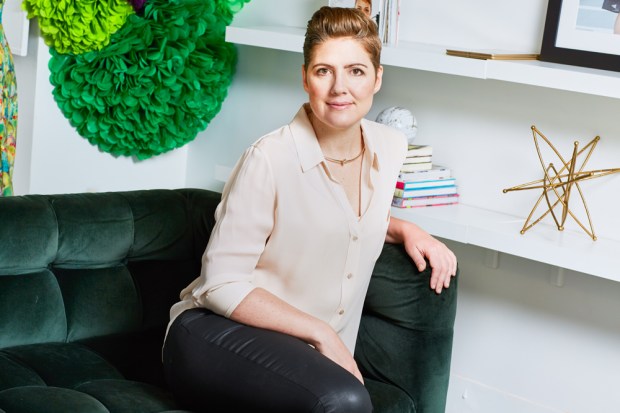Why Clothing As A Service Is The Future Of Fashion

Gwynnie Bee entered the market seven years ago with a goal of building a new eCommerce for apparel based on access, instead of ownership. Now, according to co-founder and CEO Christine Hunsicker, the brand is ready to brings its Clothing as a Service model to retail writ large and really begin disrupting how people access clothes online.
The problem with clothes shopping, Gwynnie Bee founder and CEO Christine Hunsicker told Karen Webster in a recent conversation, often comes down to commitment. Maybe the customer loves it, maybe it’s the perfect on-trend look … but when money is on the line – and, in some cases, a fairly large amount of it – the question is, do they love it enough to wear it so often they get their money’s worth?
It’s a very 20th century way to shop, Hunsicker noted, and one that is particularly ill-suited to the online shopping experience, where one is essentially buying an item of clothing sight unseen because they can’t try it on. They have to make a monetary commitment based on how something looks on someone else, and hope like heck it fits and flatters them as well as it does the model.
“So seven years ago, we were thinking about using data and tech to build a business with a strong economics unit that would positively impact the lives of consumers,” said Hunsicker. “And we did a bunch of analysis, and found that apparel wasn’t working well online and hasn’t to date – and it seemed like a massive opportunity on the tech side to build something really disruptive.”
What apparel retail needed online, Hunsicker told Webster, was a different model, one that asked consumers something a little bit different than whether they loved that item of clothing enough to own it. “Because we are selling a subscription model, we instead ask consumers if they like it enough to try it.”
Fashion by subscription, instead of by purchase, is a better model for the modern consumer. In fact, it’s such a good model that Gwynnie Bee is exporting it to other retailers via their CaaStle (Clothing-as-a-Service) platform, which will allow retailers to offer a subscription clothing rental business alongside their existing way of doing business.
But instead of selling consumers a box of clothes to keep each month for a set monthly fee, consumers can pick out a certain number of items to keep in their closets. They can wear them once, then box them up and return them for other items to wear and return. If they really do fall in love with something, they can buy it for a reduced price.
A Better Model For a Modern Client
Who buys clothing this way, you might be asking? The answer may surprise you.
The Gwynnie Bee demographic, Hunsicker noted, is working women between the ages of 25 and 48, who tend to skew a little more affluent and urban than average.
That woman faces a challenge every day: What should she wear to the office? Gwynnie Bee aspires to make answering that question as easy as grabbing something out of a box and going with a more efficient access model.
“This is someone who shows up in an office every day and is working with clients or in other public-facing capacities,” said Hunsicker. “How she presents herself to the world matters – and she knows that.”
This customer wants to be on-trend and fashionably dressed, but the reality is she doesn’t really have the time or the budget to be constantly updating and recycling her wardrobe – which is why the ownership model doesn’t work for her.
Instead, Gwynnie Bee customers can pay as little as $49 a month to take one item out at a time, or as much as $199 a month to have 10 items out at a time. All items ship for free, and consumers can exchange items as often as they desire. The average plan is $95 a month, for three items out at a time.
Most Gwynnie Bee customers prefer to swap items rather than own them, because they are renting fashion-forward items that may be too on-trend to invest in.
“We see customers who buy items that are wardrobe staples, and then pay a membership fee to access our public closet for those items that are more on trend,” Hunsicker said. “Our customers get more variety and get to experiment more with their look without having to make a really serious investment in trendy items.”
Bringing the Model to the Masses with Retailers
Unlike a model like Rent the Runway – which focuses much more on the special occasions market and the one or two times per year that most consumers are going to “be in the market for a five-thousand-dollar dress” – Gwynnie Bee is more interested in offering an “all you can eat” access play, where customers get monthly access to the clothing they wear every day, and can then maximize the value in the way the best suits their sartorial needs.
“This is like Netflix, where customers pay to rent access to their massive movie catalog instead of buying every single movie or TV series to own,” she pointed out.
The bigger issue the firm has faced is simple awareness of the best way to bring their platform to market. Because Gwynnie Bee does more than just offer their customers access to the closet, she explained – it also acts as their guide through it. They standardize sizes across and within brands, so customers aren’t left guessing at what fit they need. They learn from customers’ choices and review what types of style moves they make, so they can curate content accordingly and make appropriate recommendations.
They’re aiming for a pretty robust offering, and getting the word out about that value has been the big hill to climb in the seven or so years since firm started its journey.
“We really had to think long and hard about how to make an entire population aware of a new model that has a ton of benefits, but is still really a new retail category,” said Hunsicker. “And bringing customers into a new category is where a lot of the heavy lifting is.”
Bridging that awareness gap, she noted, was partly what building the Gwynnie Bee brand was about – they had to build the idea of Clothing-as-a-Service, which “didn’t really exist seven years ago.”
“What we want to do now is power the new eCommerce for apparel – but by licensing the technology that powers it alongside a consumer-facing brand that participates in it.”
And the desire to power the new eCommerce for apparel, she noted, is what influenced the brand’s decision to announce its latest expansion with retail partners for its CaaS platform.
Working with Retail
To work with the CaaS platform, retailers are required to send over their inventory, and Gwynnie Bee takes it from there. They perform all of the delivery and cleaning logistics in their own warehouses, build a consumer-facing, front-end suite in the retailer’s name, and get paid on a per-customer basis every time a consumer signs on with the retailer’s CaaS offering.
This kind of partnership, Hunsicker said, had been Gwynnie Bee’s long-term goal since its initial launch. In the last six months, it has been operating in stealth with its initial integration partners, which has been highly encouraging.
First, she noted, it gives retailers a better way to judge the success of their offerings beyond just what customers buy. A shopper may love a floral blazer, but it’s such a specific item that the same customer might not be sure about adding it as a permanent addition to their closet. Working with Gwynnie Bee’s platform offers those retailers the ability to offer a try-before-you-buy option that takes the commitment question off the table.
“When you go to buy, you ask yourself a ton of questions,” Hunsicker pointed out. “In this new model, the only thing they have to ask themselves is if they like it enough to try it. That consideration barrier is so much lower, and consumers are a lot more willing to try to wear many more types of clothes than they are willing to buy them outright.”
But all of that trying – and all of those chances of discovery – actually lead to more buying on the whole, Hunsicker noted. The consumer gets a chance to expand their taste and broaden their fashion preview, and that means they are considering a lot more options.
Moreover, Hunsicker pointed out, it is a different – and arguably better – way to create loyalty to a retail brand than what is often offered in apparel eCommerce, where customers are given points or dollar rewards for doing basic stuff.
“That really doesn’t drive loyalty, and I think we are on the right side of history with the service-based offering,” stated Hunsicker. “This is a massive loyalty program for consumers – but because they are paying for it, they have more reasons to keep seeking out this retailer looking for more value.”
Because at the end of the day, the modern digital consumer is looking for more and better value. Sometimes – particularly in the case of staples and must-have items – that means ownership is the best model. It’s why, Hunsicker noted, they stay away from basic fashion items at Gwynnie Bee.
But in a lot of cases, particularly ones where being on-trend is a bit more pressing, access is the core value – and the thing that consumers of all stripes are really seeking. The retailers that win under this new apparel eCommerce model, according to Hunsicker, will be the ones that deliver on that value of expanded choice.
“Our retailers are seeing an increasing share of wallet; it is the exact opposite of cannibalization,” said Hunsicker.
